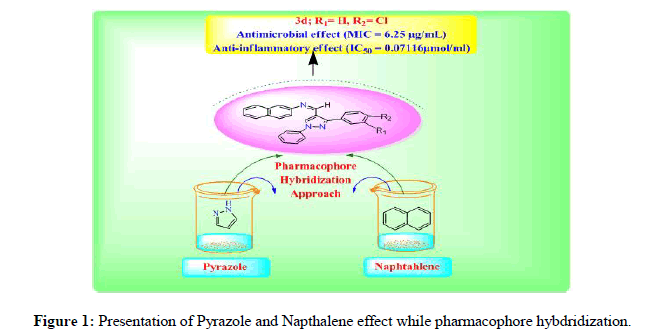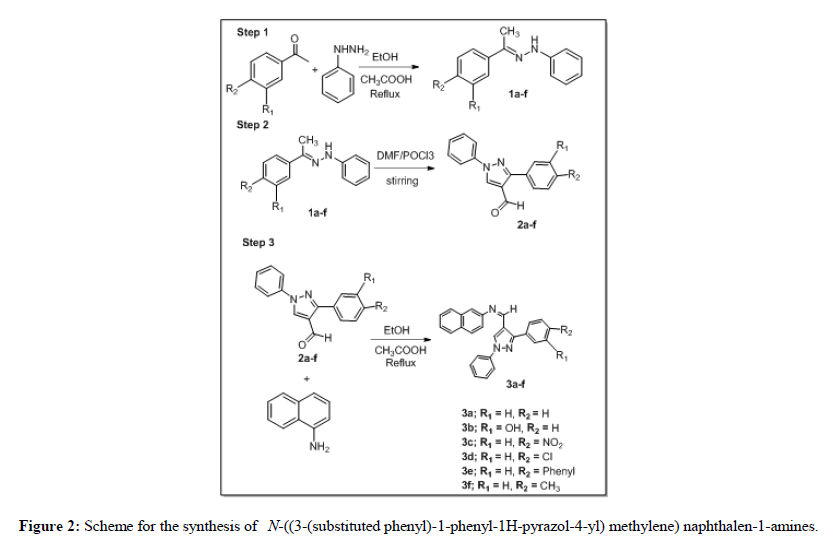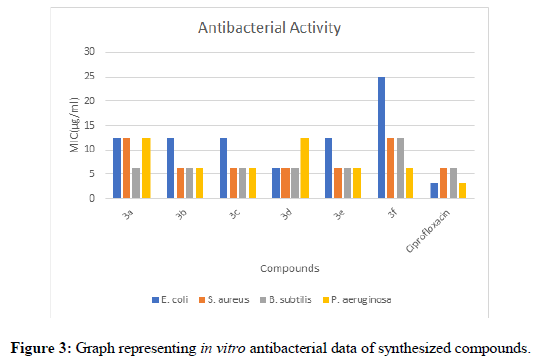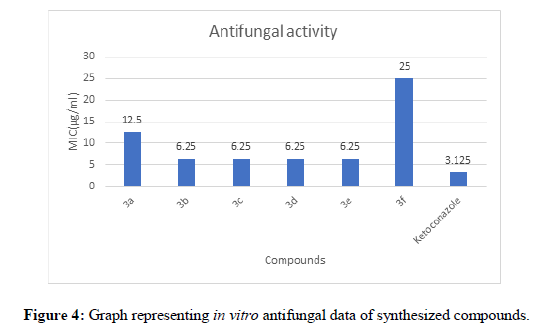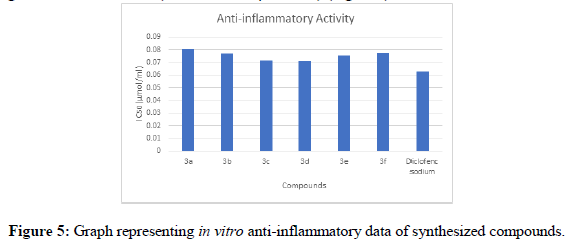Research Article - Der Pharma Chemica ( 2023) Volume 15, Issue 6
Synthesis, Anti-Inflammatory, Antimicrobial and Antioxidant Evaluation of Novel N-((3- (substituted phenyl)-1-phenyl-1H-pyrazol-4-yl)methylene) naphthalen-1-Amines
Pushpender Lamba, Manoj Kumar, Sarwan Mudgil, Bhupender Nehra* and Poonam RaniBhupender Nehra, Department of Pharmaceutical Sciences, Guru Jambheshwar University of Science and Technology, Haryana, India, Email: bhupendernehra1111@gmail.com
Received: 28-Oct-2023, Manuscript No. DPC-23-118640; Editor assigned: 31-Oct-2023, Pre QC No. DPC-23-118640 (PQ); Reviewed: 14-Nov-2023, QC No. DPC-23-118640; Revised: 17-Nov-2023, Manuscript No. DPC-23-118640 (R); Published: 15-Dec-2023, DOI: 10.4172/0975-413X.15.6.107-114
Abstract
In order to explore the therapeutic potential of pyrazole-based analogues, six Synthesis, anti-inflammatory, antimicrobial and antioxidant evaluation of novel N-((3-(substituted phenyl)-1-phenyl-1H-pyrazol-4-yl) methylene) naphthalen-1-amines (3a-f) were synthesized using multistep synthetic methodology. Structural elucidation of all synthesized molecules was performed by using IR and 1H NMR spectral reports. All molecules were accessed for their antimicrobial potential against a panel of four bacterial strains and one fungal strain. Results of in vitro antimicrobial data revealed compounds 3d as most potent antibacterial agent towards E. coli, S. aureus and B. subtilis with MIC values of 6.25 μg/mL while Compounds 3b, 3c, 3d and 3e as most active antifungal agents against tested fungal species i.e., R. oryaze (MIC=3.125 μg/mL). Further, in vitro anti-inflammatory antioxidant potential was evaluated for synthesized molecules in which compound 3d have powerful anti-inflammatory and antioxidant profile with IC50 values of 0.06289 and 0.024765 μmol/ml.
Keywords
Pyrazole; Antimicrobial; Anti-inflammatory; Antioxidant; Naphthalene
Introduction
Heterocyclic compounds are cyclic structures containing heteroatoms including nitrogen, oxygen, sulfur, phosphorus, silicon, boron and others [1]. All living cells' metabolism depends heavily on heterocyclic compounds, containing five and six-membered rings including one to three heteroatoms in the nucleus [2]. Heterocyclic derivatives are considered one of the significant classes of organic compounds, which can be used in medicinal fields, due to their activity in numerous diseases. A large number of biologically active compounds contain five-membered heterocycles, including oxazolidine, thiadiazole, oxazole, pyrazole, thiazolidine, thiazole, isothiazole, oxadiazole, isoxazole and isoxazolidine. The pharmaceutical sector is interested in these heterocycles because they form the basis of many drugs (Figure 1) [3,4].
Five membered heterocyclic motifs are special to medical chemistry. Pyrazole is one of the most noticeable nuclei among these five membered heterocyclic skeletons, with two N and two endocyclic double bonds with π-excess electrons which make it aromatic heterocycle [5,6]. The diverse biological activities were shown by the pyrazole ring and played crucial role in medicinal chemistry. Pyrazole derivatives possessed number of biological activity like; anti-inflammatory [7], anticonvulsant [8], antibacterial [9], antifungal, anticancer [10], antioxidant, antiviral [11], antidepressant [12], antihyperglycemic, antipyretic, antihelmintic, etc. [13]. The pyrazole moiety is the most important and highly rated core unit in many drug molecules, including celecoxib, rimonabant, crizotinib, fezolamine, difenamizole, apixaban, regadenoson, granisetron, avapritinib, antipyrine, metamizole, aminophenazone, phenylbutazone, sulfinpyrazone, oxyphen butazone and many more [14-16].
Two fused benzene rings make up the polycyclic aromatic hydrocarbon known as naphthalene and all 10 π-electrons are distributed throughout the molecule make it aromatic which enhanced its stability and reactivity as that of aromatic compounds [17]. Naphthalene has been well explored and has a wide range of uses, including the synthesis of several chemical compounds, the creation of dyes, solvents and pesticides [18,19].
Naphthalene derivatives have drawn a lot of attention in the world of pharmaceutical chemistry because of the possible therapeutic uses of them [17]. Naphthalene is a useful scaffold for drug development because of its rigid and planar structure, which enables interactions with particular biological targets [20]. The antagonistic properties of naphthalene’s include anticancer [21-23], antibacterial [24], antipsychotic [25], antiinflammatory [26], antiviral [27], antidiabetic [28], anti-fungal [29], antitubercular [30], antihypertensive [31], anticonvulsant [32], and antidepressant [33]. Many naphthalene possessing medications have received USFDA approval and are being marketed for treatment include naproxen, duloxetine, lasofoxifene, bedaquiline, propranolol, adapalene, cinacalcet, bunaftine and tolnaftate etc. and also many scaffolds are in under clinical trials [34]. Many marketed drugs also possessed pyrazole and naphthalene moiety in their structure which is responsible for their activity [35-36]. Due to the stated biological potential of pyrazole and naphthalene derivatives in the literature, we pursued the synthesis of N-((3- (substituted phenyl)-1-phenyl-1H-pyrazol-4-yl) methylene) naphthalen-1-amines.
Materials and Methods
Experimental
All chemicals of analytical grade were used for the synthesis which were purchased from SRL (India) and Hi-media (India), used without further purification. The synthesized derivatives were checked by using TLC (Thin Layer Chromatography), by using silica gel G and 3:2 n-hexane: Ethyl acetate solvent system to monitor the progress of all procedures. The Decibel melting point apparatus and an open capillary tube were used to measure the melting points, which were then expressed in degrees Celsius. Perkin Elmer IR spectrophotometer was used for the IR spectra of the compounds by using KBr pellets technique. For the 1HNMR, a proton nuclear magnetic resonance spectrum of the derivatives, Bruker Advance II 400 NMR spectrometer was used. Chemical shifts were described in δ values downfield from tetramethylsilane, while CDCl3 was used as solvent. The NMR signal multiplicity is represented by the letters s, d, t, q, m and bs, which, respectively, stand for singlet, doublet, triplet, quartet, multiplet and wide singlet. Values for the coupling constant (J) are given in hertz.
Preparation of hydrazones: Equimolar amount of acetophenone and phenyl hydrazine were taken in clean RBF containing ethanol as solvent followed by addition of GAA in catalytic amount. Then, the reaction mixture was refluxed at 90°C for 3-4 hours. The completion of reaction was observed by TLC. After completion of reaction, flask was kept at room temperature for better precipitation after that content was filtered and washed with aqueous alcohol. Finally, filtered precipitates were dried through vacuum drying for obtaining moisture free product.
Preparation of pyrazole carbaldehydes: 1 gm of phenylhydrazone was taken in suitable amount of DMF in ice cold temperature. Then, POCl3 was taken three folds amount as than that of DMF and added in reaction mixture in dropwise manner with continuous stirring. Stir further for one hour and then reaction content was refluxed at 90°C for six to eight hours. After completion of reaction, content was poured in ice cold water followed by its neutralization with 1N NaOH. Then precipitates of pyrazole carbaldehyde were collected through filtration and washed with aqueous alcohol for getting pure product. Finally, precipitates were dried carefully and weighed.
General Procedure for synthesis of N-((3-(substituted phenyl)-1-phenyl-1H-pyrazol-4-yl)methylene)naphthalen-1-amines Equimolar amount of pyrazole carbaldehyde and β-naphthylamine were taken in clean RBF containing ethanol as solvent followed by addition of glacial acetic acid in catalytic amount. Then, the reaction mixture was refluxed at 90°C for 12-14 hours. TLC was used to monitoring the completion of reaction. After completion of reaction, flask was stored at room temperature for better precipitation and then content was filtered and washed with alcohol (Figure 2 and Table 1).
| Compounds | Molecular formula | Molecular weight | Melting point (°C) | Rf value | % Yield |
|---|---|---|---|---|---|
| 3a | C26H19N3 | 373 | 160 | 0.85 | 84 |
| 3b | C26H19ON3 | 389 | 170 | 0.82 | 76 |
| 3c | C26H18O2N4 | 418 | 140 | 0.68 | 82 |
| 3d | C26H18ClN3 | 407.5 | 170 | 0.82 | 70 |
| 3e | C32H23N3 | 449 | 150 | 0.78 | 78 |
| 3f | C27H31N3 | 387 | 140 | 0.64 | 82 |
Table 1: Physicochemical data of various synthesized final N-((3-(substituted phenyl)-1-phenyl-1H-pyrazol-4-yl) methylene) naphthalen-1-amines”(3a-f).
Solvent system=(Ethyl acetate: n-Hexane; 4:6) N-((1,3-diphenyl-1H-pyrazol-4-yl)methylene)naphthalen-1-amine (3a) Yield: 84%, light brown solid, Mp: 160°C Mol. Wt.: 373, Mol. Formula: C26H19N3.IR (KBr, cm-1) ν max: 3048 (Aromatic-CH), 1599 (C=N),1447, 1539, 1052 (-C=C), (-C=N), (-N-N) pyrazole. 1H NMR (400 MHz, CDCl3, δ ppm): 8.83 (s, 1H, –CH=N), 8.66 (s, 1H, Pyrazole-CH), 7.00-7.95 (m, 17H, Ar- H)”.
3-(4-((naphthalen-1-ylimino)methyl)-1-phenyl-1H-pyrazol-3-yl)phenol (3b) Yield: 76%, white solid, Mp: 170°C Mol. Wt.: 389, Mol. Formula: C26H19ON3. IR (KBr, cm-1) ν max: 3056(Aromatic-CH), 1615 (C=N),1444, 1537, 1059 (-C=C), (-C=N), (-N-N) pyrazole, 3398 (O-H).1H NMR (400 MHz, CDCl3, δ ppm): 8.80 (s, 1H, -CH=N), 8.65 (s, 1H, Pyrazole-CH), 6.90-8.38 (m, 16H, Ar- H), 5.25 (s, 1H, -OH).
N-((3-(4-nitrophenyl)-1-phenyl-1H-pyrazol-4-yl) methylene) naphthalen-1-amine (3c) Yield: 82%, light yellowish solid, Mp: 140°C Mol. Wt.: 418, Mol. Formula: C26H18O2N4.IR (KBr, cm-1) ν max: 3050 (Aromatic-CH), 1597 (C=N),1424, 1531, 1077 (-C=C), (-C=N), (-N-N) pyrazole.1H NMR (400 MHz, CDCl3, δ ppm): 8.80 (s, 1H, -CH=N), 8.66 (s, 1H, Pyrazole-CH), 7.02-8.38 (m, 16H, Ar- H)”.
N-((3-(4-chlorophenyl)-1-phenyl-1H-pyrazol-4-yl)methylene)naphthalen-1-amine (3d) Yield: 70%, light brown solid, Mp: 170°C Mol. Wt.: 407.5 , Mol. Formula: C26H18ClN3. IR (KBr, cm-1) ν max: 2925 (Aromatic-CH), 1600 (C=N),1401, 1501, 1092 (-C=C), (-C=N), (-N-N) pyrazole, 835 (C-Cl).1H NMR (400 MHz, CDCl3, δ ppm): 8.78 (s, 1H, -CH=N), 8.63 (s, 1H, Pyrazole-CH), 7.00-8.35 (m, 16H, Ar- H)”.
N-((3-((1,1'-biphenyl)-4-yl)-1-phenyl-1H-pyrazol-4-yl)methylene)naphthalen-1-amine (3e) Yield: 78%, light brown solid, Mp: 150°C Mol. Wt: 449, Mol. Formula: C32H23N3. IR (KBr, cm-1) ν max: 3054 (Aromatic-CH), 1599 (C=N),1447, 1539, 1052 (-C=C), (-C=N), (-N-N) pyrazole.1H NMR (400 MHz, C DCl3, δ ppm): 8.81 (s, 1H, -CH=N), 8.72 (s, 1H, Pyrazole-CH), 7.06-8.06 (m, 21H, Ar- H)”.
N-((1-phenyl-3-(p-tolyl)-1H-pyrazol-4-yl)methylene)naphthalen-1-amine (3f) Yield: 82%, light brown solid, Mp: 140°C Mol. Wt: 387, Mol. Formula: C27H31N3. IR (KBr, cm-1) ν max: 3047 (Aromatic-CH), 1597 (C=N), 1459, 1538, 1055 (-C=C), (-C=N), (-N-N) pyrazole, 2910 (Ali-CH).”1H NMR (400 MHz, CDCl3, δ ppm): 8.83 (s, 1H, -CH=N), 8.64 (s, 1H, Pyrazole- CH), 7.05-8.41 (m, 16H, Ar- H), 2.43 (s, 3H, -CH3).
In vitro Biological evaluation
Antimicrobial activity: A well-established standard serial dilution technique was used to perform a preliminary antibacterial screening for all the synthesized compounds. “Pseudomonas aeruginosa (Gram negative, MTCC 647) Escherichia coli (Gram negative, MTCC 16521) Staphylococcus aureus (Gram positive, MTCC 3160) Bacillus subtilis (Gram positive, MTCC 441) and Rhizopus oryzae (MTCC 262)” were the bacterial and fungal strains used for the study, respectively. Ciprofloxacin and Ketoconazole were used as a standard drug for antibacterial and antifungal action, respectively. 100 ml of sterile normal saline solution and 1 ml of fresh microbe culture were combined to form the microorganism suspension, which was used for the biological evaluation. 10 mg of the synthesized derivatives were dissolved in 10 ml of DMF (di-methyl formamide) and obtained 1000 μg/ml concentration which was further diluted to 100 μg/ml with DMF. Test tubes having concentration 50, 25, 12.50, 6.25 and 3.125 μg/ml were prepared by using 1ml of freshly prepared autoclaved broth medium and sabouraud dextrose broth which is obtained by dissolving 1.3 g and 3 g in 100 mL of distilled water in case of bacteria and fungus, respectively. It was ensured that the starting bacterial concentration was constant across all samples and then inoculated standardized bacterial culture into each test tube. For a predetermined amount of time, often 24 hours for bacteria and 120 hours for fungus incubated the test tubes 37°C at the right temperature. Visually checked each tube for turbidity or growth after incubation. Found the MIC (minimum inhibitory concentration), which was the amount of an antibacterial agent needed to stop bacterial growth, that can be discovered by looking at the tube that didn't exhibit any growth or color changed.
Anti-inflammatory activity: In this in vitro study, diclofenac sodium was used as reference to perform anti-inflammatory evaluation for synthesized compounds. Hereby, certain dilutions (50, 40, 30, 20 and 10 μg/mL) were prepared for synthesized pyrazole naphthalene hybrid derivatives while Dimethyl Formamide (DMF) was taken as solvent. From prepared dilutions, 1ml of each resulting solution was transferred in separate test tubes and labelled properly. Further in each test tube, add 1.4 ml of freshly prepared phosphate buffer having pH of 6.4 followed by 0.1 ml egg albumin (obtained from fresh egg) for 15 minutes at 37°C ± 2°C. After that, resultant test tubes were heated at 70°C for 5 minutes. Moreover, test tubes were cooled at room temperature followed by detection of their absorbance by UV spectroscopy at 660 nm wavelength.

Antioxidant activity: Antioxidant activity was assessed by using the DPPH assay method. The principle of the assay is that the colour turns from violet to yellow when DPPH reacts with the antioxidant. For assessing the antioxidant activity of the synthesized derivatives Ascorbic acid was used as the standard. For preparing the DPPH solution we dissolved 3.94 mg in 100 ml of ethanol. DMF and DPPH were taken blank and control, respectively. Certain dilutions (50, 40, 30, 20 and 10 μg/mL) were prepared by using synthesized pyrazole clubbed naphthalene derivatives while Dimethyl Formamide (DMF) was taken as solvent.1ml of the test sample was taken in each of test tube which was followed by addition of DPPH solution and placed for 30 minutes in dark, during this time purple colour changed into yellow. Then the absorbance was recorded at 517 nm. The % antioxidant potential was calculated using the following:

Results and Discussion
Chemistry
In first step, phenyl hydrazine and different substituted acetophenones were condensed to obtain hydrazones (1a-f). Six para, ortho and meta substituted acetophenones including -H, -NH2, -Cl, -OH, -CH3 and -Ph substituent on benzene ring were used for synthesis. Further, all the synthesized hydrazones were cyclized into pyrazole-4-carbaldehydes (2a-f) by Vilsmeier-Haack reagent, whose melting point matched with that which was reported. The final products (3a-f) were obtained by reaction of pyrazole carbaldehyde with α-naphthylamine in presence of GAA in catalytic amount. Physiochemical characterization of the synthesized derivatives is given in Table 2. The compounds were characterized by using spectral data (IR and 1H NMR). All compounds exhibited single spot on TLC which justified the formation single desired compounds. All the compounds of series (3a-f) showed C=N stretching in range of 1596-1612 cm-1 and aromatic (-CH) stretching between 2910-3150 cm-1. In 1H NMR spectrum, the multiplet was appeared between 7.00 ppm-8.41 ppm that can be attributed to aromatic protons. Schiff base which was confirmed by singlet ranged between 8.78 ppm-8.83 ppm and also singlet of hydrogen of pyrazole ring was found in range of 8.63 ppm-8.72 ppm.
Antimicrobial activity of N-((3-(substituted phenyl)-1-phenyl-1H-pyrazol-4-yl) methylene) naphthalen-1-amines” Antibacterial activity (Minimum inhibitory concentration) was assessed by using broth dilution method against four bacterial strains viz: Staphylococcus aureus (SA), Bacillus subtilis (BS) representatives of Gram-positive bacteria while Pseudomonas aeruginosa (PA) and Escherichia coli (EC) were G-negative strains involved in the study. Ciprofloxacin was used as reference drug for the comparison of antibacterial activity. The activity is reported as MIC values presented in μg/mL for the derivatives as determined by using broth micro dilution method.
Results of antibacterial evaluation data demonstrated that the tested compounds (3a-f) were found to be active against the various tested bacterial strains. Some of the assessed compounds exhibited potent to good antibacterial activity as compared to the reference drug ciprofloxacin while few compounds highlighted superior activity profile against the tested bacterial strains when compared to ciprofloxacin, however, all were equal or less active than the reference drug ciprofloxacin. Analysis of the MIC data highlighted that most of the derivatives presented good potencies against the G-negative bacterial strain E. coli. It was observed that almost synthesized compounds were presented significant antibacterial profile with MIC values ranged between 6.25 to 12.5 μg/ml. Among the series, compound 3d possessed most promising activity against E. coli with MIC value 6.25 μg/mL which can be compared with the reference drug ciprofloxacin (MIC=3.125 μg/mL). Further, compounds 3f was least potent amongst the series because of presence of electron donating group (-CH3) towards E. coli with MIC value of 25 μg/ml whereas, all the remaining compounds demonstrated excellent inhibitory potency against E. coli with MIC values in the range of 12.5 μg/ml. However, all the tested compounds explored good antibacterial activity towards the tested gram negative bacterial strains compared to the standard drug ciprofloxacin (MIC=3.125 μg/mL) (Figure 3).
Against the gram positive bacteria S. aureus, derivatives 3b, 3c, 3d,and 3epresented the highest potency with MIC value of 6.25 μg/ml, which was equal to that of ciprofloxacin (MIC=6.25 μg/mL). Other compounds 3a and 3h displayed second most effective inhibitory activity against S. aureus with MIC value of 12.5 μg/ml, which was comparable to reference drug (MIC=6.25 μg/mL). Against B. subtilis, derivatives 3a, 3b, 3c, 3d and 3e presented the strongest antibacterial potency (MIC=6.25 μg/mL) which was comparable to reference drug ciprofloxacin (MIC=6.25 μg/mL). Remaining derivative 3f presented good inhibitory activity with MIC values of 12.5 μg/ml. Moreover, against P. aeruginosa, most of the tested derivatives 3b, 3c, 3e and 3f highlighted remarkable activity against this bacterial strain with MIC (6.25 μg/mL) which is comparable antibacterial activity (MIC=3.125 μg/mL) against P. aeruginosa as that of standard drug Ciprofloxacin. Further, compounds 3a and 3d presented second most potency with MIC value of 12.5 μg/ml.
Antifungal activity of the tested derivatives (3a-f) was assessed against human pathogenic fungal strain R. oryaze by using ketoconazole as the reference antifungal drug. The result of antifungal activity was summarized in Table 2. Among the various evaluated compounds, 3b, 3c, 3e and 3d demonstrated superior antifungal activity against R. oryaze with a MIC value of 6.25 μg/mL, which was comparable to the reference drug ketoconazole (MIC=3.125 μg/mL) (Figure 4).
Further, derivative 3f demonstrated least activity with MIC value of 25 μg/ml. Further, remaining analog 3a showed good inhibitory potential against tested fungal strain with MIC values 12.5 μg/mL, when compared to the standard drug ketoconazole.
| S. No. | Code no. | E. coli | S. aureus | B. subtilis | P. aeruginosa | R. oryaze |
|---|---|---|---|---|---|---|
| 1 | 3a | 12.5 | 12.5 | 6.25 | 12.5 | 12.5 |
| 2 | 3b | 12.5 | 6.25 | 6.25 | 6.25 | 6.25 |
| 3 | 3c | 12.5 | 6.25 | 6.25 | 6.25 | 6.25 |
| 4 | 3d | 6.25 | 6.25 | 6.25 | 12.5 | 6.25 |
| 5 | 3e | 12.5 | 6.25 | 6.25 | 6.25 | 6.25 |
| 6 | 3f | 25 | 12.5 | 12.5 | 6.25 | 25 |
| 7 | Ciprofloxacin | 3.125 | 6.25 | 6.25 | 3.125 | ----------- |
| 8 | Ketoconazole | --------- | ---------- | -------- | ---------- | 3.125 |
Table 2: In vitro antimicrobial activity (MIC values) of the tested compounds (μg/ml).
Anti-inflammatory activity of N-((3-(substituted phenyl)-1-phenyl-1H-pyrazol-4-yl) methylene) naphthalen-1-amines”
Anti-inflammatory potential of the designed compounds (3a-f) was established as IC 50 values while % inhibition was also established at different concentration levels such as 10, 20, 30, 40 and 50 μg/ml. It was found that among the synthesized derivatives most of synthesized analogues demonstrated good to potent anti-inflammatory effect with IC50 values ranged between 0.07116 μmol/ml-0.08043 μmol/ml, as compared to reference anti-inflammatory agent diclofenac sodium (IC50 =0.06289 μmol/mL) (Figure 5).
Results of in vitro anti-inflammatory activity demonstrated that among the all analogs, 3d derivative found to be most potent anti-inflammatory agent with IC50 value of 0.07116 μmol/ml and percentage inhibition value of 62.75% at 50 μg/ml followed by 3c (IC50=0.07176 μmol/ml, % inhibition at 50 μg/mL=61.37%). The result of anti-inflammatory activity was summarized in Table 3.
| Sr. No. | % zone of inhibition | IC50 μg/ml | IC50 μmol/ml | ||||
|---|---|---|---|---|---|---|---|
| Concentration μg/ml | |||||||
| 50 | 40 | 30 | 20 | 10 | |||
| 3a | 91.0344 | 82.7586 | 75.1724 | 60 | 54.4827 | 30.0006 | 0.08043 |
| 3b | 73.1034 | 71.0344 | 68.2758 | 65.5172 | 62.0689 | 29.9963 | 0.07711 |
| 3c | 61.3793 | 53.1034 | 51.7241 | 38.6206 | 34.4827 | 29.9986 | 0.07176 |
| 3d | 62.7586 | 57.2413 | 55.1724 | 48.9655 | 44.1379 | 28.9981 | 0.07116 |
| 3e | 55.862 | 48.9655 | 42.7586 | 30.3448 | 17.2413 | 33.8973 | 0.07549 |
| 3f | 79.3103 | 71.7241 | 68.9655 | 67.5862 | 57.931 | 29.9988 | 0.07751 |
| Diclofenac sodium | 89.6551 | 85.5172 | 84.1379 | 77.2413 | 73.1034 | 20 | 0.06289 |
Table 3: In vitro anti-inflammatory activity of the tested compounds 3a-f (μmol/mL).
Antioxidant activity of N-((3-(substituted phenyl)-1-phenyl-1H-pyrazol-4-yl) methylene) naphthalen-1-amines” Antioxidant activity of the synthesized compounds (3a-f) was demonstrated as IC50 values while % inhibition was also established at different concentration levels such as 10, 20, 30, 40 and 50 μg/ml. It was found that among the synthesized derivatives most of synthesized analogues exhibited good to potent anti-oxidant effect with IC50 values ranged between 0.066737-0.134787 μmol/ml, as compared to standard antioxidant agent Ascorbic acid (IC50=0.024765 μmol/ml) (Figure 6).
Results of in vitro activity highlighted that among all compounds, 3d was found to be most potent anti-inflammatory agent with IC50 value of 0.066737 μmol/ml and percentage inhibition value of 30.33% at 50 μg/ml followed by 3c (IC50=0.073236 μmol/ml, % inhibition at 50 μg/mL=43.93%). The result of antioxidant activity was summarized in Table 4.
| Sr. No. | % zone of inhibition | IC50 μg/ml | IC50 μmol/ml | ||||
|---|---|---|---|---|---|---|---|
| Conc. μg/ml | |||||||
| 50 | 40 | 30 | 20 | 10 | |||
| 3a | 45.8427 | 44.83146 | 43.70787 | 43.37079 | 41.23596 | 50.2756 | 0.134787 |
| 3b | 30.89888 | 29.4382 | 24.38202 | 18.53933 | 16.51685 | 29.6446 | 0.076207 |
| 3c | 43.93258 | 37.41573 | 35.8427 | 25.2809 | 22.92135 | 30.6125 | 0.073236 |
| 3d | 30.33708 | 27.64045 | 24.38202 | 15.2809 | 13.14607 | 27.1954 | 0.066737 |
| 3e | 36.51685 | 29.4382 | 21.1236 | 20.78652 | 19.88764 | 39.7147 | 0.088451 |
| 3f | 48.08989 | 47.07865 | 44.83146 | 43.37079 | 41.23596 | 47.8273 | 0.123585 |
| Ascorbic acid | 71.01124 | 68.31461 | 63.25843 | 61.01124 | 48.53933 | 4.3587 | 0.024765 |
Table 4: In vitro antioxidant activity of synthesized compounds (3a-f).
Conclusion
In conclusion, we have synthesized six new N-((3-(substituted phenyl)-1-phenyl-1H-pyrazol-4-yl) methylene) naphthalen-1-amines (3a-f) and determined their physicochemical (melting point) and spectral characterization using FT-IR and 1H-NMR spectroscopy. Outcomes of antimicrobial highlighted that some of tested derivatives presented good to potent inhibition against the tested microbial species. Some of the tested compounds exhibited both comparable or equal potency than standard drug Ciprofloxacin and Ketoconazole against the tested bacterial and fungal strains, respectively. Among synthesized series, compounds 3d showed equipotent antibacterial activity against S. aureus, B. Subtilis and E. coli. Derivatives 3b, 3c, 3d and 3e exhibited comparable antifungal effect as than that of reference drugs used. Further, anti-inflammatory data revealed compound 3d as more promising agent than standard anti-inflammatory drug diclofenac sodium. Furthermore, antioxidant data demonstrated that compound 3d was found to be most potent among the synthesized derivatives. From the study we can conclude that electron withdrawing group at para position of the phenyl ring showed most potent activity, while the compound having para electron withdrawing group showed least activity.
Acknowledgement
The authors acknowledge the vice chancellor, Guru Jambheshwar university of science and technology, Hisar for his constant support and motivation.
Conflict of Interest
The authors declare no conflict of interest.
References
- Atmaram UA, Roopan SM. Appl Microbiol Biotechnol. 2022; 106(9-10):p. 3489-3505.
[Crossref] [Google Scholar] [PubMed]
- Saini MS, Kumar A, Dwivedi J, et al. Int J Pharm Sci Res. 2013; 4(3):p. 66-77.
- Balaban AT, Oniciu DC, Katritzky AR. Chem Rev. 2004; 104(5):p. 2777-2812.
[Crossref] [Google Scholar] [PubMed]
- Al-Mulla A. Der Pharma Chem. 2017; 9(13):p. 141-147.
- Karrouchi K, Radi S, Ramli Y, et al. Mol. 2018; 23(1):p.134.
[Crossref] [Google Scholar] [PubMed]
- Kumar KA, Jayaroopa P. Int J Pharmtech Res. 2013; 5(4):p. 1473-1486.
- Szabó G, Fischer J, Kis-Varga Á, et al. J Med Chem. 2008; 51(1):p. 142-147.
[Crossref] [Google Scholar] [PubMed]
- Kaushik D, Khan SA, Chawla G, et al. Eur J Med Chem. 2010; 45(9):p. 3943-3949.
[Crossref] [Google Scholar] [PubMed]
- Qin HL, Liu J, Fang WY, et al. Eur J Med Chem. 2020; 194 (8):p.112245.
[Crossref] [Google Scholar] [PubMed]
- Balbi A, Anzaldi M, Macciò C, et al. Eur J Med Chem. 2011; 46(11):p. 5293-5309.
[Crossref] [Google Scholar] [PubMed]
- Genin MJ, Biles C, Keiser BJ, et al. J Med Chem. 2000; 43(5):p. 1034-140.
[Crossref] [Google Scholar] [PubMed]
- Parmar SS, Pandey BR, Dwivedi C, et al. J Pharm Sci. 1974; 63(7):p. 1152-1155.
[Crossref] [Google Scholar] [PubMed]
- Verma R, Verma SK, Rakesh KP, et al. Eur J Med Chem. 2021; 212: 113-134.
[Crossref] [Google Scholar] [PubMed]
- Naim MJ, Alam O, Nawaz F, et al. J Pharm Bioallied Sci. 2016; 8(1):p. 2.
[Crossref] [Google Scholar] [PubMed]
- Shawish I, Barakat A, Aldalbahi A, et al. ACS omega. 2022; 7(28): 24858-24870.
[Crossref] [Google Scholar] [PubMed]
- Li X, Yu Y, Tu Z. Mol. 2021; 26(5): p. 120-122.
[Crossref] [Google Scholar] [PubMed]
- Rokade YB, Sayyed RZ. Rasayan J Chem. 2009; 2(4): p. 972-980.
- Borwitzky H, Schoburg G. J Chromatogr A. 1979; 170: 99-124.
- Buckpitt A, Kephalopoulos S, Koistinen K, et al. World Health Organization. 2009; 34(17): p. 56-60
- Platella C, Napolitano E, Riccardi C, et al. J Med Chem. 2021; 64(7): p. 357-368.
[Crossref] [Google Scholar] [PubMed]
- De Groot FM, Loos WJ, Koekkoek R, et al. J Org Chem. 2001; 66(26): p.8815-8830.
[Crossref] [Google Scholar] [PubMed]
- Valente S, Trisciuoglio D, De Luca T, et al. J Med Chem. 2014; 57(14): p. 6259-6265.
[Crossref] [Google Scholar] [PubMed]
- Abate C, Niso M, Lacivita E, et al. J Med Chem. 2011; 54(4): p. 1022-1032.
[Crossref] [Google Scholar] [PubMed]
- Laverty G, McCloskey AP, Gilmore BF, et al. Biomacromol. 2014; 15(9): p. 3429-3439.
[Crossref] [Google Scholar] [PubMed]
- Goudie AC, Gaster LM, Lake AW, et al. J Med Chem. 1978; 21(12): p. 1260-1264.
[Crossref] [Google Scholar] [PubMed]
- Jeleń M, Bavavea EI, Pappa M, et al. Med Chem Res. 2015; 24(5): p. 1725-1732.
[Crossref] [Google Scholar] [PubMed]
- Debnath AK, Radigan L, Jiang S. J Med Chem. 1999; 42(17): p. 3203-3209.
[Crossref] [Google Scholar] [PubMed]
- Bokor E, Kun S, Goyard D, et al. Chem Rev. 2017; 117(3): p. 1687-1764.
[Crossref] [Google Scholar] [PubMed]
- Zheng S, Wu W, Jiang Q, et al. Nat Prod Res. 2022; 20 (6): p. 89-93.
- Wilkinson RG, Shepherd RG, Thomas JP, et al. J Am Chem Soc. 1961; 83(9): p. 2212-2213.
- Atwal KS, O'Reilly BC, Ruby EP, et al. J Med Chem. 1987; 30(4): p. 627-635.
[Crossref] [Google Scholar] [PubMed]
- Walker KA, Wallach MB, Hirschfeld DR. J Med Chem. 1981; 24(1): p. 67-74.
[Crossref] [Google Scholar] [PubMed]
- Ang W, Chen G, Xiong L, et al. Eur J Med Chem. 2014; 82: p. 263-273.
[Crossref] [Google Scholar] [PubMed]
- Makar S, Saha T, Singh SK. Eur J Med Chem. 2019; 161: p. 252-726.
[Crossref] [Google Scholar] [PubMed]
- Naim MJ, Alam O, Nawaz F, et al. J Pharm Bioallied Sci. 2016; 8(1): p. 2-4.
[Crossref] [Google Scholar] [PubMed]
- Salem ME, Mahrous EM, Ragab EA, et al. BMC Chem. 2023; 17(1): p. 1-7.
[Crossref] [Google Scholar] [PubMed]

